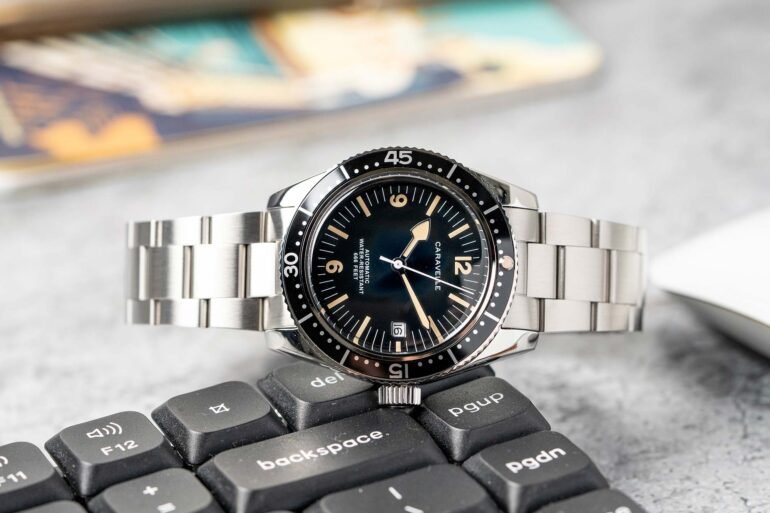Every so often, you come across new releases that feel less like a stranger and more like someone you’ve met before, but can’t quite place. This feeling cropped up more and more as the vintage revival trend took a firm grasp on the watch industry, as brands rushed to bring back “iconic” references from the obscure archives. However, from the moment the Caravelle Sea Hunter hit my hand and that feeling crept in, it probably wasn’t for the reason you might assume. To be fair and to frame this review properly for all of you, I have only spent two brief periods of romance with Sea Hunter up until now. That has been enough time for me to claim that the Caravelle by Bulova is here to fill a void left by one of, if not the, most legendary dive watches ever made for the modern audience, the Seiko SKX. However, we can circle back to that in a moment.
Caravelle was launched as the more affordable younger sibling operating underneath the Bulova brand in 1962 as a direct competitor to Timex. Offering jeweled movements at a price point that others could not, Caravelle eventually grew to become the largest-selling jeweled-movement watch manufacturer in the United States by 1968. In that swath of mass-produced affordable wrist watches sat a line of diving tool watches bearing the name Sea Hunter, with the soon-to-be iconic 666 depth rating, which brought about the ‘Devil Diver’ nickname.
It was one of those Devil Divers, released in 1969, that Caravelle chose to do something a bit unorthodox with in swapping out their typical manually wound Japanese caliber for an automatic Swiss-made ETA caliber 2472 with 17 jewels and a more reliable frequency. This odd model bore the Swiss Made stamp on the dial and a set of vintage arrow hands we now typically associate with the Longines Legend Diver. As luck would have it, our friends over at The Watch Preserve in Texas just happened to have an example of the relatively rare Swiss-made Caravelle Sea Hunter sitting in their showroom. They were gracious enough to loan it to me for a side-by-side comparison, which we do not typically get a chance to do when reviewing reinterpretation pieces.
Despite the odd naming convention, the Caravelle by Bulova carries the build quality you would associate with the modern entry-level Bulova collection rather than what most of us have come to know from Caravelle. Intended to separate the watch from the more fashion-focused larger collection of Caravelle, this Sea Hunter serves as the kickoff point for an intermediate collection between the two, carrying attributes from Bulova with the price point closer to Caravelle. Staring at the modern version alongside the vintage, you have to applaud the efforts in sticking with the original design language rather than simply taking inspiration like so many others. The new Sea Hunter looks simultaneously modern and of the 60s. Apart from the upsizing to fit contemporary preferences and the apparent lack of wear, it is an almost one-to-one reinterpretation that could have simply been a different production run from the original period. From nearly every angle, the new design has been slightly bolstered to hit modern specifications that are tested for today’s day and age, not something that every vintage watch can claim.
While the vintage version follows vintage dimensions with a case diameter of 35mm, a lug-to-lug of 41.4mm, and an impressive thinness of 11.6mm, the modern Sea Hunter hits the sweet spot for a contemporary audience. At 39mm in diameter, the Caravelle lives in a range that enthusiasts have been screaming for for quite some time. At 45.5mm from lug-to-lug, it is well-suited for most wrist sizes without feeling oversized on small wrists or diminutive on large wrists like mine. However, the thin profile is gone as the modern depth testing and domed mineral crystal stack up to create a height of 14.3mm. Though, as you can tell by the photos, it by no means wears as large as that dimension might betray, and instead still feels like a relatively compact diver, giving hints of its vintage-inspired architecture.
Inspecting the Sea Hunter, you realize that someone at Bulova was listening to the community, trying to pack in as many enthusiast details as possible for the set target price. Thankfully, the 200 meters of water resistance remains thanks to a screw down crown and screw in caseback. That may sound like an obvious statement, but as we have seen before, it is a detail easily overlooked by large brands. Set between the 20mm lugs is a steel bracelet that tapers down to 18mm at the fold-over clasp with a divers extension and several micro adjustment points. That bracelet also uses solid endlinks equipped with quick-release spring bars, so if you find yourself underwhelmed with the slightly jangly nature of the bracelet, you can easily swap it out for any number of nylon or rubber options. Its bezel offers decent grip with slightly tinny sound and comes fitted with an aluminum bezel insert with lume pip at 12, ready to age with the wearer. It still carries the date window on a much smaller scale so as not to dominate the dial surface while still offering functionality. All details scream that someone on the design team not only cares about the original vintage watch but also took the time to understand the enthusiast’s point of view and what could be achieved given the brand’s parameters.
I would usually dive into a watch’s finishing and expand on what the brand delivers for its price point, but that is not why we are here. The Sea Hunter carries a very industrial finish with mostly polished surfaces that will show wear with vertical brushing covering the bracelet. Our hardcore diver audience will quickly bemoan polishing on a dive watch. However, at this price point, it is to be expected as the technique can easily cover tooling and elevate the look quickly on a larger scale in manufacturing. Polishing also catches light in a display case quite well, which stakeholders love from a brand used to exhibiting watches in jewelry cases. When placed next to the Seiko SKX, or even better, its modern competitor, the Orient Mako, the Sea Hunter holds its own and carries a charm that I think may resonate with some more than the other two.
Clearly, its design language leans on the vintage side of things with hands rarely seen on modern watches and brown hued lume. It may put some off as the tonal shift does affect the lume’s performance in low light conditions, as it may not shine quite as bright or as long as some others, though it still performs adequately. However, for those who don’t mind the vintage coloration, there is something romantic about the combination of vintage dial design language and heavily domed mineral crystal. They combine cohesively, even when the raw aluminum numerals on the bezel stand out as more modern. It almost begs for a leather or distressed canvas pass-through strap to make itself ready for a photo shoot, propped up against vintage military memorabilia.
Powering the Caravelle by Bulova Sea Hunter is the automatic Miyota caliber 8215-33E. A reliable albeit attainable caliber with 21 jewels, four more than the original, operating at 3 Hz with a stated accuracy of -20 to +40 seconds per day. The three-hand caliber provides an adequate 42 hours of power reserve, date compilation, and hacking seconds. While this may only make sense to my fellow shake n’ bake SKX owners, there is something fantastically fun about the slightly crunchy feeling you get winding the Miyota 8000 series movements, knowing that although they might not be keeping the most accurate time, they will keep on ticking.
In many ways, the Sea Hunter fits a similar bill to the beloved yet discontinued Seiko SKX that, no matter how much we want it, will never come back. It is that void that I believe the Sea Hunter aims to fill and may do just that. They carry similar movement specifications, though the Sea Hunter has slightly better accuracy and offers hacking. To compare the bracelets would be a crime, as the romantically terrible SKX bracelet is great because of how bad it is. Dimensionally, the SKX uses its weird Seiko magic to fit every wrist, whereas the Sea Hunter pulls off more wearable measurements. Now, they are quite different visually, with the Seiko leaning more modern and the Caravelle reaching into the past, but both have a similar vibe and carry their own charm. I’ll remind you again that the SKX is dead; long live the SKX.
One other cult classic lived alongside the SKX, though, and remains a part of the brand’s modern collection to this day: the Orient line of dive watches. Pick your flavor here, whether you prefer the Mako, Kamasu, Ray, or any other JDM release that somehow floated over to the States; each one offers similar specifications and quite a bit of value. As a proud owner of the Orient Mako, it is a shame to see the MSRP now float up to $575, though it can still often be found at the same price as the Caravelle, right around $375. For the price, Orient does give you a day complication, better lume, a sapphire crystal, but bigger dimensions in every way but thickness. You cannot go wrong if the Orient design language speaks to you. Throughout my time owning this piece, the design language has always felt sterile and failed to capture much of my wrist time. I have heard a tale from other collectors who thought they found the value-packed diver of the century, only to hunt down their own SKX and then replace it.
At $375, it is really hard to find a point to argue against the Sea Hunter. Sure, I can easily put together a wish list of changes I want to see made, but the price goes up with every single one of those tweaks. I find an intangible joy in the relatively inexpensive automatic diver that I have not felt since purchasing my old SKX007. While I hope the Caravelle by Bulova line continues to expand, I hope the Sea Hunter line expands first. At launch, we have the option of black with tan lume, a green and gold tone theme on a bracelet, a blue and gold tone on a rubber strap, and the surprisingly attractive black and rose gold tone on rubber version. I would love to see a more basic black or blue and white version creep into the collection for those looking for a more modern offering in an entry-level automatic diver.
One of the real charms of this watch is that I finally have a new answer to the question “What is the best first automatic watch I should buy?” The Seiko SKX served as my answer for a long time, and since its discontinuation, I have had to scramble with many options. I will, of course, still tailor my answer to the individual, but the Caravelle by Bulova Sea Hunter has made a valiant effort to knock many watches off the level list. Caravelle
Devin Pennypacker
2025-09-17 20:00:00










